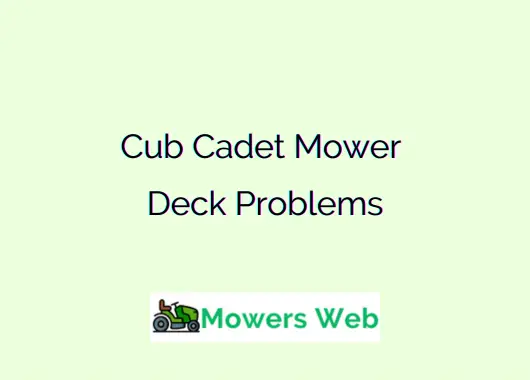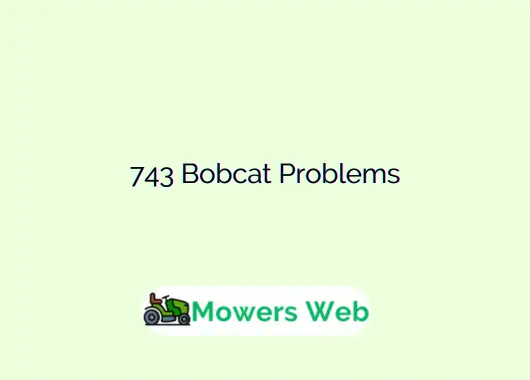The mower deck is a critical component responsible for cutting grass evenly and efficiently. When problems arise, they can affect the quality of the cut, the mower’s performance, and even its longevity.
In this post, we’ll explore seven common Cub Cadet mower deck problems, their causes, and practical solutions to keep your mower running smoothly.
Cub Cadet Mower Deck Problems
1. Uneven Cutting
One of the most frequent complaints with Cub Cadet mower decks is uneven cutting, where the lawn appears patchy or scalped in certain areas. This issue often stems from an uneven mower deck. If the deck is not properly aligned, one side may cut lower than the other, resulting in an uneven appearance.
Solution: Check the deck’s levelness by parking the mower on a flat surface and measuring the blade height on both sides. Adjust the deck using the leveling bolts or knobs as outlined in your Cub Cadet manual. Ensure tire pressures are equal, as uneven tire inflation can also cause the deck to tilt. Regularly inspect the blades for wear, as dull or bent blades can contribute to uneven cuts.
Related Cub Cadet Belt Size Chart(For All Models)
2. Clogging Under the Deck
Grass clippings and debris buildup under the mower deck can reduce cutting efficiency and cause clogs, especially when mowing wet or thick grass. This is a common issue with Cub Cadet mowers, particularly in humid conditions.
Solution: After each use, clean the underside of the deck with a scraper or pressure washer to remove grass and debris. Avoid mowing wet grass, as it tends to stick more readily.
Consider applying a non-stick coating, such as a mower deck spray, to reduce buildup. Regularly inspect and clean the discharge chute to ensure proper airflow and clipping expulsion.
Related Cub Cadet Zero Turn Tire Pressure Chart(For All Models)
3. Blade Vibration or Wobbling
Excessive vibration or wobbling during operation can indicate a problem with the mower deck’s blades or spindle. This issue can lead to poor cutting performance and potential damage to the deck or other components.
Solution: Inspect the blades for damage, such as bends, nicks, or imbalances. Replace any damaged blades, ensuring they are the correct size and type for your Cub Cadet model. Check the blade spindle for wear or looseness, as a damaged spindle can cause wobbling. Tighten or replace loose or worn spindle bolts, and ensure the blades are securely fastened.
Related Cub Cadet Riding Mower Problems(7 Problems + Solutions)
4. Deck Belt Slipping or Breaking
The mower deck belt drives the blades, and if it slips or breaks, the blades won’t spin properly, resulting in no cutting or inconsistent performance. This issue is often caused by wear, improper tension, or debris interfering with the belt’s operation.
Solution: Inspect the deck belt for signs of wear, such as fraying or cracking, and replace it if necessary. Check the belt tension according to your mower’s manual and adjust it to the recommended specifications. Remove any debris, such as grass or twigs, from the pulleys and belt path. Regularly lubricate pulleys to reduce friction and extend belt life.
5. Rust and Corrosion on the Deck
Rust and corrosion can develop on the mower deck, especially if it’s exposed to moisture or stored improperly. Over time, rust can weaken the deck, leading to holes or structural failure.
Solution: After each use, clean the deck to remove grass, dirt, and moisture that can promote rust. Store the mower in a dry, covered area to protect it from the elements.
If rust appears, sand the affected areas and apply a rust-resistant primer and paint designed for metal surfaces. Consider investing in a deck with a protective coating or opting for a stainless steel or composite deck if available for your model.
Related Are Cub Cadet Blades Reverse Threaded(Answered)
6. Scalping or Gouging the Lawn
Scalping occurs when the mower deck cuts too low, removing too much grass and leaving bare patches or ruts. This problem is often caused by setting the deck height too low or mowing over uneven terrain.
Solution: Adjust the deck height to the appropriate level for your grass type and terrain, typically 2-3 inches for most lawns. Avoid mowing over dips or bumps at high speeds, as this can cause the deck to dig into the ground.
Use the mower’s anti-scalp wheels (if equipped) to prevent the deck from dropping too low. Regularly level the deck to ensure consistent cutting height.
Related Mower Deck Spindle Bolts Torque Chart(For All Brands + Models)
7. Excessive Noise from the Deck
Unusual or excessive noise, such as rattling or grinding, coming from the mower deck can indicate loose components, worn bearings, or debris caught in the deck.
Solution: Inspect the deck for loose bolts, pulleys, or brackets and tighten them as needed. Check the spindle bearings for wear and replace them if they’re noisy or feel rough when rotated.
Remove any debris lodged in the deck or around the blades. If the noise persists, consult a professional technician to diagnose potential internal damage to the deck or spindle assembly.
Related Common Cub Cadet RZT 50 Problems(With Solutions)
Preventative Maintenance Tips
To minimize mower deck problems, adopt a regular maintenance routine. Sharpen or replace blades at least once per season, as dull blades can strain the deck and engine.
Lubricate moving parts, such as pulleys and spindles, to reduce wear. Inspect the deck for cracks, dents, or other damage before each use.
Final words
Cub Cadet mower deck problems, such as uneven cutting, clogging, vibration, belt issues, rust, scalping, and excessive noise, can disrupt your mowing experience, but most are preventable or fixable with proper care. Regular maintenance and prompt repairs are key to extending the life of your Cub Cadet mower and achieving optimal performance.




